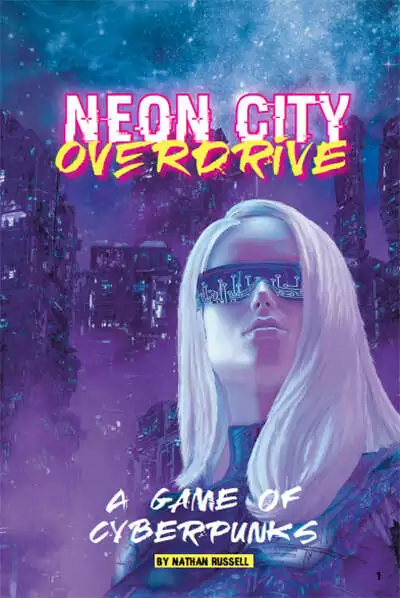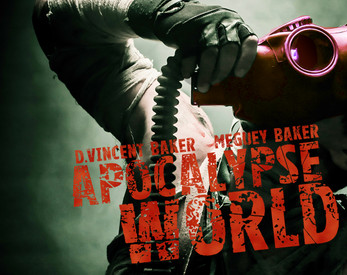Neon City Overdrive Cyberpunk; Dark; Narrative-Driven; Character Customization; Skill-based; Collaborative Worldbuilding
Neon City Overdrive is a streamlined tabletop roleplaying game set in a dark, dystopian cyberpunk world. It emphasizes narrative-driven gameplay and tactical combat through a unique dice pool system based on character Trademarks, Edges, and Flaws. Its setting is a flexible sandbox, encouraging players to define their version of cyberpunk. The game is designed to be fast-playing and accessible, making it suitable for both newcomers and experienced RPG players who want a less crunchy, more story-focused experience.
Theme and Setting
Neon City Overdrive plunges players into a gritty cyberpunk future heavily influenced by classics like Akira, Blade Runner, and Neuromancer. The setting details a dystopian urban sprawl defined by stark contrasts: gleaming metroplexes housing the privileged, sprawling industrial complexes known as 'Grinders,' and the desolate 'No-Zone' outside the city walls. Above, the ultra-rich reside in orbiting space colonies, often equipped with 'ghost chips' that promise virtual immortality.
The game deliberately offers a sandbox environment, leaving many technological and societal details open to player interpretation. While ubiquitous cybertech, gene hacking, and a pervasive virtual network called 'the Grid' are core elements, the specifics are malleable. This allows game masters to tailor the setting to their group's preferences, whether that means maintaining familiar aspects of modern society or venturing into more radical extrapolations of cyberpunk tropes. The focus is on a world where individuals struggle against oppressive systems, driven by personal goals amidst technological advancements and social decay.
Core Mechanics and Rules
The core mechanic revolves around a dice pool system using six-sided dice (d6). Players build a pool of Action dice based on relevant character Trademarks (akin to aspects in Fate), Edges, and situational advantages. Simultaneously, Danger dice are added for character Trauma, negative conditions, and hindrances. Rolls of 1-3 are failures, 4-5 are partial successes, and 6 are full successes.
A key element is that Danger dice cancel out Action dice of the same value, creating a dynamic risk-reward system. Partial successes typically come with complications, mirroring mechanics found in Powered by the Apocalypse games.
Combat is resolved using the same dice pool system. Actions are categorized as either Quick (e.g., attacking, grabbing an object) or Focused (e.g., precise shots, hacking). Movement is zone-based, with areas defined as Close, Near, Far, and Distant. Stunt Points function similarly to Fate points, allowing players to manipulate dice rolls, introduce scene details, or utilize additional Trademarks. These points are awarded at the beginning of each job or when a character's Flaws create significant complications.
The game encourages mission-based play, with a structured approach to jobs involving hooks, gearing up, the job itself, and downtime activities. Gear rolls abstract the acquisition of essential items, adding a layer of preparation and resource management.
Unique Aspects
Neon City Overdrive distinguishes itself through its simplicity and flexibility. Unlike more rules-heavy cyberpunk RPGs, it avoids exhaustive lists of equipment and intricate stats, opting instead for a narrative-focused approach. The Trademark, Edge, and Flaw system allows for diverse character creation without bogging down in granular details.
The COOL framework (Concept, Objective, Obstacle, Link) provides a simple structure for designing jobs, drawing inspiration from Dungeon World's front system.
The game also utilizes clocks, inspired by Blades in the Dark, to represent escalating tension and looming complications.
Another strength lies in its emphasis on character Drive. This serves as a central motivation for each character, guiding their actions and providing a long-term goal to pursue. Progress on this Drive Track is tied to downtime activities and impacts character advancement, fostering campaign play and investment in the narrative.
Target Audience and Player Experience
Neon City Overdrive is tailored for players who enjoy narrative-driven gameplay and collaborative worldbuilding. Its rules-light system makes it accessible to newcomers while still offering enough tactical depth to engage experienced roleplayers. The game particularly appeals to those who appreciate the cyberpunk genre but prefer a less crunchy, more improvisational style of play.
The focus on character Drives and the COOL framework encourages players to actively participate in shaping the story and world around them. Character creation is quick and allows for self-expression, focusing on defining Trademarks and choosing Edges and Flaws. The streamlined mechanics and emphasis on player-facing rolls help keep the game moving at a brisk pace. It is suitable for groups of 3-5 players (including the GM). Overall, Neon City Overdrive aims to provide a fast, fun, and engaging cyberpunk experience that prioritizes storytelling over simulation.



